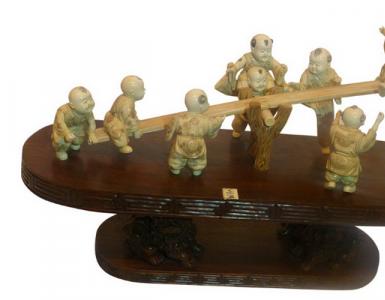Culturally trade honorable labor poster. Culturally trading in Cuba is an honorable job. Poster "We will ensure the growth of the people's well-being through exemplary trade!"

Propaganda political poster- the main type of Soviet poster. The political propaganda poster used various artistic techniques and means, in particular, the methods of caricature, cartoon, satire, etc. were widely used. In addition to plot posters, posters were produced in which the main thing was a text of great social resonance (quotes from the works of the classics of Marxism-Leninism, calls of the CPSU Central Committee, texts of the national anthem of the Soviet Union, etc.). In these posters, the expressiveness of the text was only enhanced by visual elements - ornaments, allegorical and symbolic images, etc.
The origins of the political poster go back to political cartoons and engravings that circulated in Western Europe (Germany, England and France) in the 17th and 18th centuries.
In Russia, the prototype of the poster is folk pictures that were widely popular in the 18th-19th centuries - lubok and anti-Napoleonic sheets of 1812. The first revolutionary posters appeared in Russia in 1901. The poster achieved enormous development after the Great October Socialist Revolution. In the USSR, the political poster turned into a new independent type of fine art, which actively helped the development of the national economy of the USSR, responding to the most pressing issues of our time.
Poster "We will ensure the growth of the people's well-being through exemplary trade!"

Instructional posters, at one time widespread in all sectors of the national economy, were intended to disseminate advanced labor methods in industry, transport, and agriculture; they contributed to the introduction of new equipment and advanced technology, increasing labor productivity and production culture. Instructional posters also include health education and safety posters.
Health education posters served to familiarize the population with the prevention and fight against diseases, and called for compliance with sanitary and hygienic standards in everyday life and at work.
Poster "Children must brush their teeth thoroughly"

Safety posters widely used in industry, transport, state and collective farms. For urban and railway transport, posters were issued that explained to passengers the safety rules or the use of transport (in particular, posters illustrating traffic rules in artistic form). In addition to the general short text, instructive posters could also include descriptions of methods and techniques for carrying out the necessary activities. The group of safety posters should also include posters on fire safety measures.
Poster "Check before you go!"

Educational posters were produced in a wide variety of fields of knowledge - geography, topography, botany, geology, astronomy, physics, chemistry, etc. These posters were widely used as visual aids in educational institutions and during industrial training. A special group of educational posters and aids consisted of posters produced on the instructions of DOSAAF for various defense circles (radio, aircraft and ship modeling, automoto, etc.) and for the population. Educational posters, as a rule, had a number of graphic and photo-illustrative drawings or diagrams provided with explanatory text.
Poster "Fly with Aeroflot planes!"

"Textile industry workers! More durable fabrics and beautiful products!"

Poster "Oh, such fruits are harmful!"

Poster "Trade in a cultural manner is an honorable work!"

Poster quality requirements. The main requirement: the printing design must correspond to the original made by the artist and the copy of the publication signed by the publisher for printing. The following were considered defects: mismatch of colors during two- and multi-color printing, distorting the image; stains, paint drips, smearing of paints and “streaking” in the drawing, as well as stains on blank areas of the print; oily, torn, dirty and wrinkled sheets with a tear out of the chalky layer (in cases where posters were printed on coated paper), with clips (wrinkles), sealed bent corners, etc. Quantity and quality were checked by viewing and counting individual pieces opened for exposure packs or tubes. The defect was returned to the supplier.
Poster "If there is war tomorrow..."

Poster trade. Wholesale trade in posters produced by central publishing houses was carried out by the All-Union Association of Book Trade - Soyuzkniga of the Ministry of Culture of the USSR ("Soyuzkniga", the All-Union Association of Book Trade, formed in 1958 to carry out a centralized wholesale supply of book products. In 1973, the association became part of the Main Directorate of Books trade and propaganda of books of the State Committee of the Council of Ministers of the USSR for publishing, printing and book trade), and posters produced by republican, regional and local publishing houses - the corresponding book trades. Retail trade was carried out in cities and workers' villages through the bookselling network, in stationery stores, and Soyuzpechat newspaper and magazine kiosks; in regional centers and in rural areas - through the trade network of consumer cooperation. In Moscow and in large republican centers there were specialized stores selling art products, including posters. The main types of notification to the retail network about poster products being prepared for release were the annual thematic plans of publishing houses with inserts for placing orders and the Soyuzbook “Order Forms” issued regularly, in which the annotated names of the posters that were in print were published. In addition, publishing houses practiced sending out information letters through the trade network with lists of published political posters and with their photocopies. Local booksellers had to promptly notify institutions and organizations, large industrial enterprises, etc. about the upcoming arrival and subsequent receipt of relevant publications at the warehouse. In specialized stores, posters were hung in window display cases and in prominent places inside the store and were provided with serial numbers, under which they were listed in the store’s assortment. The buyer named the numbers he needed, and the seller selected posters using these numbers.
Poster "Cotton fabrics"

Packaging, transportation and storage. Posters were packaged by printing companies in packs or “tubes” weighing no more than 8 kg (for ease of mailing without repackaging). The number of copies of posters in a pack or “tube” must be the same for the entire publication. Posters of ¼ sheet or smaller format were packaged in closed flat packs with a “slot” arrangement; when formatted in sheets or larger - in the same packs, stacked in one or two parallel folds. Each pack had to be wrapped in two layers of packing paper and tied with twine. The edges of the pack should have been sealed with quick-drying glue. Transportation was carried out, as a rule, in cardboard boxes and containers in primary printed packaging. Posters were stored on racks in rooms protected from dampness and direct sunlight. The permissible relative humidity in the room should not exceed 70%.
Poster for the feature film "Beware of the Car"

Poster for the feature film "White Sun of the Desert"

V. Govorkov. "Trade in a cultural manner is an honorable job!" Poster. 1949
The other day I went to the Pyaterochka store on the eve of closing (about 11 pm) to buy yogurt. And I became an involuntary witness to such a scene: the hall was almost empty, there were no customers at the checkout, and, taking advantage of the pause, the worker sitting at the checkout (an oriental-looking girl) dared to talk on her mobile phone. It was then that some lady from the store management caught her, probably the director or deputy director. When I approached the cash register, the lady hissed furiously at the cashier:
- I’m warning you for the last time! I'll see you again - dismissal! An explanatory note on my desk in the office, and a telephone! If you want to communicate on your cell phone, stay at home!..
The girl didn’t answer, she just smiled guiltily, lowering her eyes.
And somehow I remembered with longing the Soviet times, when store workers did not fawn over customers at all, did not fawn, did not flash white-toothed smiles, but behaved, perhaps, even too rudely. Which many people didn’t like, and for this they were constantly denounced and “educated” in the press, almost from 1918 until 1991. 
Shubina G.K. “Be a cultured seller: show off the product, choose something that suits your face... Honor to such a seller!” Postcard. 1958

Typical caricatures of Soviet-era trade workers
Catch phrases of the then Soviet saleswomen and cashiers: “There are many of you, but I am alone!”, “There is no meat without bones!” (this is if a customer in the meat department complained that there were too many bones in a piece of meat), etc. Yes, the press tried to “educate” trade workers, but without much success. However, is the current syrup politeness any better? After all, behind many of today’s exquisitely polite phrases like “what interests you?” (this question is deliberately constructed in such a way that it cannot be answered in monosyllables, one has to enter into explanations) one feels fierce hatred for the buyer. In addition, for that matter, there were “oases” of haberdashery in the USSR - anyone who wanted to fully enjoy it could go to the bazaar, where the sellers were usually treacly kind and invited buyers with all their might. (“Run in, hurry up, buy a painting!”).
They say that disadvantages are always a continuation of advantages, and vice versa. The current syrupy courtesy of the sellers is a continuation of their own continuous bourgeois “training” and humiliation. The ineradicable “Jacobin rudeness” of service workers in the USSR is a consequence of the fact that the Soviet ideal was the equality of all people, and “servants” or “servants” were not considered inferior to those whom they served. Who likes what more...
Nowhere is Cuban socialism more evident than in the area of commerce. You walk into a Cuban store and it’s like being transported back to childhood. When I was little, we had a grocery store near our house with the beautiful name “Diet”. By 1991, there were fewer and fewer products there, but the managers very skillfully disguised this - the goods were laid out on large counters and display cases in increasingly artistic ways, the main thing being that the shelves did not look empty. But enough about the Moscow of my childhood. Today about trade in Havana.
Photo provided by Makatun. Larger
Here's an expensive store for you. Here are all prices in . At first glance there is a lot of stuff here! But, if you look closely, you can see that the majority of the assortment is deodorants/shampoons as well as alcoholic drinks. Let's take a closer look at the grocery section:
The packages on the counter are apparently placed in such a way as to fill up more space (though not very successfully). And in the far corner there are canned goods and pasta. Here's a store for the rich.
For the rich, there is also a shopping center. Shops and merchandise boutiques are located along a spiral gallery - it winds circles around the atrium in the center. The illuminated rectangle on the second floor is a huge TV showing football. People go to the shopping center not so much for shopping, but for entertainment. There are eateries here - all selling the same ice cream and sandwiches, but the prices are very high for the average Cuban. Personally, I remember GUM.
We went into an electronics store here and saw that 90% of the items were bulky stereo speakers, in the style of the early nineties.
But let's get back to food. Here's another store for the rich. Soup packets are sold at dumping prices - from 65 cents to $1.20 (don't forget that these prices are in American dollars). Luxurious choice. These aren't Nissin Cup Noodles for 79 cents! Again, you should notice how everything is laid out. Obviously, foreigners are ashamed of the meager choice (I think locals can’t afford to spend a dollar on a bag of soup.)
We see the same thing in the international terminal of the airport - boxes of cookies are strategically placed here. A departing tourist will not even suspect that there may be food problems in the country - after all, the entire shelf is full!
But a person is not satisfied with soup and cookies alone. What about meat?
Here is the meat department of an expensive grocery store. The choice consists of some minced meat, hamburgers, and sausages. All this has some kind of unhealthy color, as if “the products do not exceed the level of toilet paper content established by the standard.”
Once we came across real meat - albeit chicken. These delicious legs are sold in the heart of old Havana, in a luxurious grocery store right opposite the closed Capitol. The prices here are such that no one is in a hurry to sort out this poyo.
But there are real queues at the shops selling at “proletarian” prices. People stand together in families, communicate, listen to music. It looks like they've been here for a long time.
Street trading is developed. For example, they sell some cakes. We were not impressed by the quality of baked goods in Cuba, although there are a lot of bread products here (their abundance compensates for the lack of everything else).
Or here's a guy selling onions and peppers from an open truck. At such street points you can buy better quality products, but they usually do not please you with the wealth of choice.
Although sometimes you come across these enterprising dudes with vegetable carts. Here we sometimes sell fruit at crossroads, but in Cuba this is the best way to stock up on fresh vegetables. Prices are also very affordable, everything is calculated in national pesos. The main thing is to catch such a cart. They mostly ride in the first half of the day.
What Cuba doesn't have a problem with is alcohol. This was noticeable even in the first photo. And here’s what an expensive store looks like on the ground floor of the most expensive hotel:
Abundance pleases the eye. Although the prices here are “for tourists”. Locals prefer to drink national rum Havana Club - a bottle can be bought at a kiosk for $2. It's in the center - probably if you look hard enough, you can find it cheaper on the outskirts. Due to the fact that trade is state-owned, prices in all stores should be the same. Those who don't want to invest in a whole bottle can drink at retail in one of the many local bars.
The guys are enjoying the weather and cheap rum. Don’t look at the fact that one of them is so squeamish, we had a wonderful conversation with them, and even drank. The guy just doesn't want extra fame.
Here's how local catering workers pass the time. There are no clients, you can sleep a little.
Here is another very interesting establishment - a mobile phone tuning shop. Mobile communications in Cuba appeared several years ago, but there is still very little mobile Internet. Yes, and Wi-Fi is expensive. That’s why people take their smartphones to places like this so that new versions of applications can be installed. It's cheaper and faster than downloading the new version of Facebook for Android, which weighs tens of megabytes.













